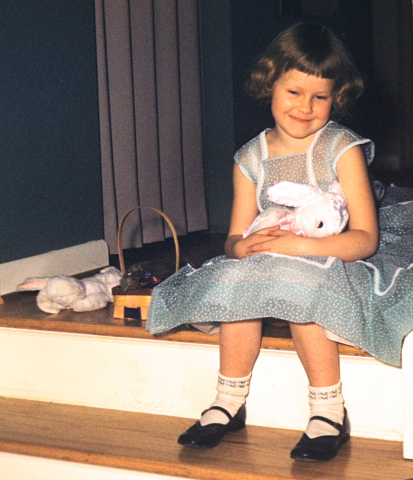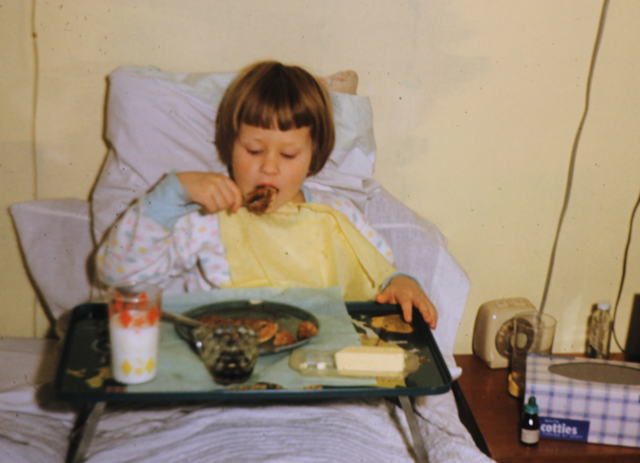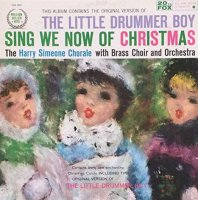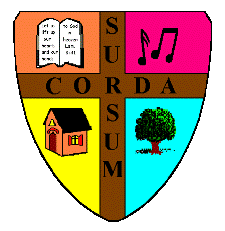Having lived through more than seven decades of holidays, I decided it would be of interest (to me, if no one else) to consider how the various annual celebrations have changed, or not changed, as I've lived my life.
As a child, I knew that holidays were about three things: family, presents, and days off from school. Not necessarily in that order—since family was the ocean in which I swam, I didn't necessarily recognize how central it was to our observances. The only celebration from which we children were excluded was my parents' anniversary. I remember being sad about that as a child, and I admire those who celebrate anniversaries as the "family birthday." What a great idea! But "date night" was unheard of in that era, and their anniversary was one of the rare times my parents would splurge on dinner in a restaurant.
Yes, folks, basically the only time we ate out was on vacations, where Howard Johnson's—with its peppermint stick ice cream—was the highlight. Solidly middle class as we were, with an engineer's salary to support us, restaurant meals simply did not fit into our regular budget. "Not even McDonalds?" you ask. Brace yourself: I was born before the first McDonalds franchise. But even when our town did get a McDonald's, the idea of paying someone to fix a meal my mother could make better at home seemed crazy.
But back to the holidays. I'll go chronologically, which means beginning with New Year's Day, which could just as well go last, as New Year's Eve. Other people may have celebrated with big bashes and lots of champagne, but we almost always spent New Year's Eve with family friends, either at their home or ours. My parents and the Dietzes had been friends since before any children were born, and by the time each family had four we made quite a merry party all by ourselves. I think the adults usually played cards, and we kids had the basement to ourselves. Of course there was that other important feature at a party: food. Lots of good food, homemade of course.
Those who didn't fall asleep beforehand counted down to the new year, and toasted with a beverage of some sort. The adults may have had a glass of champagne. One year Mr. Dietze set off a cherry bomb in the snow, which was amazing (and illegal) in the days before spectacular fireworks became ubiquitous. I miss the awe and wonder that rarity engendered. After a little more eating and talking, we gathered up sleeping children and went home. As it was the only time of the year we were allowed to stay up to such an hour, that too was a treat. Once a year past midnight is still about right for me, though sadly it didn't stay that rare.
Valentine's Day was next. This was not the major holiday it is today, and it was mostly child-centered. In elementary school we created paper "mailboxes" for delivery of small paper Valentines to our classmates; Here's an example of what they looked like. (Click to enlarge.) Some of them may have sounded romantic, but nothing could have been further from our minds. It was just a friend thing, and we enjoyed trying to match the sentiments with the personalities of our friends. Back home, if there was anything romantic about it for my parents, I missed it, being far too concerned with chocolate, and small candy hearts with words on them. Sometimes I'd make a heart cake, formed using a square cake and a round cake cut in half, and decorated with pink frosting and cinnamon candy hearts.
There were two more February holidays that no one celebrates anymore: Abraham Lincoln's birthday on the 12th, and George Washington's on the 22nd. We would get one day or the other off from school, but not both. Nowadays they've morphed into President's Day, which is in February but I never remember when because it keeps changing.
March brought St. Patrick's Day, which was bigger in school than anywhere else, chiefly through room decorations with green shamrocks, leprechauns, and rainbows with pots of gold. In elementary school, some of our neighborhood kids had formed a small singing group—we mostly sang on the bus, but one year our teacher heard about it and persuaded us to go from classroom to classroom singing what Irish songs we knew. Back then, my family didn't know we had some Irish ancestors, so as far as I can remember, the holiday never went beyond the school door.
 Easter, of variable date, was of course a big deal. Unlike Christmas, it had mostly lost its Christian significance in favor of bunnies and chicks, eggs and candy. Except for when we were with our grandparents and had to dress in our Easter finery and go to church. The going to church part was okay; the finery not so much.
Easter, of variable date, was of course a big deal. Unlike Christmas, it had mostly lost its Christian significance in favor of bunnies and chicks, eggs and candy. Except for when we were with our grandparents and had to dress in our Easter finery and go to church. The going to church part was okay; the finery not so much.
We kids would put out our Easter baskets the night before, and awaken to find them filled with candy; often toys appeared also. Our baskets were sometimes bought at a store, but often homemade—I remember using a paper cutter to make strips from construction paper, and weaving them into baskets.
For me, the best part was our Easter egg hunt. None of this plastic egg business! We had dyed and decorated real hard-boiled eggs beforehand, and our parents hid them around the house, supplemented by foil-wrapped chocolate eggs, before going to bed on Easter Eve. What a blessing it was to live where it was cool enough at Easter time that eggs could safely be left overnight without fear of spoilage or melting.
Easter dinner was almost always a ham, beautiful and delicious, studded with cloves, crowned with pineapple rings, and covered with a glaze for which I wish I had the recipe. I know we did not always have a "canned ham"—for one thing, I remember the ham bone—but the experience of a canned ham was memorable, since they had to be opened with a "key" at risk of life and limb—or at least of mildly damaged fingers.
May brought Memorial Day, which was always May 30, not this Monday-holiday business. When it fell on a school day, it was a day off, which we always appreciated. There was usually a Memorial Day parade, in which we sometimes participated, with band, scout, or fire department groups. There was always something related to the real meaning of the holiday, but we kids never paid attention to the speeches. Our family was well-represented in wartime contributions, but rarely talked about them, and no one had died, so the holiday has no sad associations in my memory.
 Mother's Day was in May, also; what I remember most was fixing breakfast in bed for our mother. For some reason, in those days, eating breakfast in bed was regarded as something special. I have no idea why. For me, the practice is associated with being sick, as back then children were expected to recuperate in bed for a ridiculously long time. We even had a special tray, with games imprinted on it, for sick-in-bed meals. Why a healthy adult would voluntarily eat a meal in bed is still beyond my comprehension.
Mother's Day was in May, also; what I remember most was fixing breakfast in bed for our mother. For some reason, in those days, eating breakfast in bed was regarded as something special. I have no idea why. For me, the practice is associated with being sick, as back then children were expected to recuperate in bed for a ridiculously long time. We even had a special tray, with games imprinted on it, for sick-in-bed meals. Why a healthy adult would voluntarily eat a meal in bed is still beyond my comprehension.
We sometimes had outings on Mother's Day, and otherwise just did our best to make sure that at the end of the day Mom was in no doubt that she was a mother many times over.
Father's Day, in June, was also low-key, although it was a bit more exciting in the years when it coincided with my brother's birthday.
Independence Day was, like Memorial Day, an occasion for parades and speeches. Our neighborhood usually had its own parade, with decorated bicycles and scooters. Occasionally we would go somewhere to see a public fireworks display, which wasn't anything like the spectacular events seen these days; nor did ordinary people generally have fireworks. Sometimes we had sparklers, and the little black dots that burned into "snakes" when you lit them. One time our neighbors had imported some mild fireworks from a state where they were legal, and we enjoyed them—all but my mother, who protested by staying inside and playing the 1812 Overture loudly on our record player (which, by the way, was monophonic).
August was entirely bereft of holidays, though we kids were busy squeezing the last drops out of our summer vacation from school. Since Labor Day was always on a Monday even before the Monday holiday bill came into being, and school always started right after that, the week or two beforehand was a favorite time for family vacations. This holiday was completely divorced from what it was intended to honor; I think I was in college, or even later, before I made the connection with the labor movement and unions.
October 12 was Columbus Day, as it will always be for me. Its chief value was in being a day of vacation. I could tell you that "In fourteen hundred and ninety-two, Columbus sailed the ocean blue," and that his boats were the Niña, the Pinta, and the Santa Maria, but that's about it.
Now Hallowe'en, that was a children's holiday! We didn't have it off from school, unless it fell on a weekend—and if it did, our schools were certain to celebrate it anyway. Costumes—usually homemade, often very clever—a parade around the school, and no doubt some special treats were the order of the day. Parents were invited to watch the parade, which was almost always held outdoors. Most of the kids walked to school, and most had parents at home who could come. Some costumes obviously had more parental help than others, but none that I recall were store-bought, nor were there any of the outlandish, sexualized, and violent costumes I've seen today—or even 35 years ago when I watched Hallowe'en parades at our own children's elementary school. Today's society would no doubt be horrified, however, at our Indians with war paint and bows and arrows, our cowboys and soldiers with toy guns, and our knights with swords.
At night, trick-or-treating was nothing like it is today. For one thing, there wasn't nearly as much loot, since we were restricted to our own neighborhoods, and most households gave our much smaller quantities of treats than is common today. None of this business of parents driving their kids all over to increase their hauls, no trunk-or-treat, no candy distributed at businesses and malls; there was little commercial about it. But we sure had fun, and much more freedom, being turned loose to roam freely within the set bounds of our neighborhood, without regard for darkness or danger or costumes that were difficult to see out of and were not festooned with reflective tape. Younger children went trick-or-treating with their parents—who had the grace to stay in the street while the children rang the doorbells on their own—or more likely, older siblings, who tended to stick a little closer in hopes some kind neighbor would offer the chaperones some candy, too. Back home, we'd gleefully sort through our haul, occasionally trading with siblings, without any concerned parents checking it out first. And of course we ate far too much candy. Only the oldest of my brothers had the strength of will to ration his; the rest of us finished ours up within a week, but he usually had some left in the freezer until the following Hallowe'en.
Most of the time, the creation of my costume was a father- and/or mother-daughter collaboration that I looked forward to all year. Offhand, I remember being a clown, a cuckoo clock, a salt shaker (to go along with my best friend, the pepper shaker), a parking meter, and a medieval knight, among others that will not immediately come to mind. After elementary school, my Hallowe'en costume days petered out, except for one year after we moved to the Philadelphia area and a group of my friends persuaded me to make the rounds with them. That's when I discovered why they were still clinging to childish pursuits: we were in a wealthier neighborhood, where rich people gave out full-sized candy bars!
Another treasured family project was carving pumpkins into jack-o-lanterns. We used real knives to cut as soon as we were responsible enough to handle them, and always illuminated our creations with candles, even though a finger or hand was bound to be mildly burned in the lighting process. Often we kept the seeds when we hollowed out the pumpkins, salting and roasting them. It was so much fun!
But there was a worm in the apple: One year, when I was at a very tender age, our jack-o-lanterns were set outside on our porch, as usual. A gang of teenage boys came rampaging through the neighborhood and viscously smashed our creations. It was heartbreaking. I still remember the sound of their stomping feet on the porch, and their gleeful yells.
On the brighter side, with some help from my mother, I once created a Hallowe'en party for my friends, with a "haunted house" in the basement, games, a craft, food, and watching Outer Limits on our little, black and white television set. (I've set the video to show just the opening theme. If you happen to watch the whole thing, and get hooked, Part 2 is here.)
As with the best holidays, there was good food, not just candy. Apple cider—real apple cider straight from the farm, unfiltered and unpasteurized, a delight that few know today. Sometimes cold, sometimes hot and mulled, depending on the weather, which at Hallowe'en in Upstate New York could be just about anything. Apples themselves, tart and delicious, of varieties difficult to impossible to find today. My mother's homemade pumpkin cookies! And pumpkin bread! A plate of cinnamon-sugar donuts, sometimes homemade but often store-bought and nonetheless delicious. Sometimes popcorn, too.
Thanksgiving. We frequently had guests for Thanksgiving dinner. My father's parents lived 200 miles away, and while it wasn't the three-hour trip it is today, it was short enough for us to get together for Thanksgiving. If it wasn't my grandparents sharing our Thanksgiving dinner, it was friends, and sometimes both. The meal was pretty standard: typically turkey, mashed potatoes, gravy, stuffing, sweet potatoes, peas, creamed onions, Waldorf salad, cranberry sauce, and rolls, with pumpkin and mincemeat pies. Once we acquired a television set (which happened when I was seven years old), there were parades on TV in the morning for the kids, and football games in the afternoon for the men. The women, no doubt, were cooking! Much later, when we lived in Pennsylvania and had grown up a bit more, the annual "Turkey Bowl" in our own backyard attracted enough friends to make an exciting touch/tag football game in the crisp November afternoon.
And finally, the best for last: Christmas.
These days, there is a Great Divide in the way Christmas is celebrated: Christian and Secular. In my youth it was not so. Christian or not, we all knew the origins and history of the occasion, and everywhere—in stores, in schools, in the public square—Santa, reindeer, snowmen, Christmas trees, presents, Mary, Joseph, Jesus, animals around the manger, shepherds, and angels mingled happily together. Even the Star and the Three Wise Men worked their way out of their proper setting of Epiphany to join the joyous throng.
I loved choosing and decorating our Christmas tree, especially the many years when we cut our own. Christmas tree farms back then were not what they are now, with their carefully-shaped trees in neatly-planted rows. Each tree had its own personality, and we often had a choice among several varieties. Finding our special tree was an adventure I looked forward to every year. The freedom of choice, and cutting the tree ourselves, were important to me. But somehow I never minded when we ended up adopting orphan trees: those chosen and cut down by other customers, then abandoned after some flaw was discovered. Our hearts went out to the poor things, often beautiful in our eyes. And our decorations easily accommodated any flaws.
Tree decorating in our household followed a standard pattern. After trimming the branches to his satisfaction, my father would set the tree in a large can (#10 comes to mind, but I can't be sure) that he filled with sand and mounted in a wooden frame that he had made. It was placed on a sheet and dressed in a homemade Christmas tree skirt. At that point, he put the light strings on. The lights were multi-colored, and much larger than the tiny lights that later became popular. Unlike the practice that continues in Switzerland today, our lights were not real, lighted candles. But burns were still possible: those incandescent bulbs could get quite hot, and Dad had to be careful with their placement.
As soon as that was done, the whole family went to town on the tree! Decorating was a joyous family affair. Each year we created anew popcorn strings, using red string and large-eyed needles. These went on first, after the lights. (Birds enjoyed the popcorn after the tree was taken down.) We had plastic ornaments that were put on the lower levels, where toddlers could reach. We had lovely glass ornaments for higher places. We had an ornament handmade by my grandmother, and several made by young children. Atop the tree was either a star with a light in it, or a glass spire, depending on our mood. The pièce de la résistance? Draping the branches with "icicles." These are hard to explain if you haven't seen them, but they were an essential part of our beautiful trees. Here's a description I found on Reddit that explains them well.
Growing up in the 50s and 60s, there were two types of "tinsel" (we called them "icicles"), the crinkly kind that was metallic, and the plastic kind that was coated with shiny silver. The crinkly kind, which I assume was the lead type, were a tad heavier so they hung straight, while the wispy plastic type was shinier and might fly around a bit. I remember once the static electricity caused them to sway when I walked right near the tree. You had to put these on one strand at a time, which was tedious. Taking them off was also an issue, you could never get all of them off. Both types seemed to fade in popularity and garland tinsel became more common by the 80s. As artificial trees became more common, "icicles" became less practical, and even garland seemed to fall out of favor. "Icicles" looked best on an open-style Balsam Fir type of tree, and not so good on fuller trees like a Scotch Pine and Douglas Fir.
Even our family became less enthusiastic about icicles when the lead kind was replaced by the plastic, which we considered a very inferior substitute. Not the same thing at all! We did (usually) wash our hands after handling the lead....
 I haven't mentioned music, which was always an important part of the season. Everyone knew the standard Christmas carols back then, and just as with the displays, Silent Night, O Little Town of Bethlehem, and O Come, All Ye Faithful mingled happily with Jingle Bells and Rudolph the Red-Nosed Reindeer. We sang at home, we sang in school, we sang at community events. Instead of a solitary volunteer manning a red kettle and ringing an annoying bell, the Salvation Army band treated passersby to carols in excellent brass arrangements. And of course we played our favorite Christmas records while decorating our tree. One of my favorites was Sing We Now of Christmas, with the Harry Simeone Chorale. Although the album cover featured on this YouTube playlist is different, it has the exact songs from our record, and I was thrilled to discover it.
I haven't mentioned music, which was always an important part of the season. Everyone knew the standard Christmas carols back then, and just as with the displays, Silent Night, O Little Town of Bethlehem, and O Come, All Ye Faithful mingled happily with Jingle Bells and Rudolph the Red-Nosed Reindeer. We sang at home, we sang in school, we sang at community events. Instead of a solitary volunteer manning a red kettle and ringing an annoying bell, the Salvation Army band treated passersby to carols in excellent brass arrangements. And of course we played our favorite Christmas records while decorating our tree. One of my favorites was Sing We Now of Christmas, with the Harry Simeone Chorale. Although the album cover featured on this YouTube playlist is different, it has the exact songs from our record, and I was thrilled to discover it.
During my young childhood, my family went reasonably regularly to church—a small Dutch Reformed church in tiny Scotia, New York. We did not, however, go to church on Christmas. Christmas Eve and Christmas morning were strictly family time.
Christmas Eve. What do I remember about Christmas Eve? Chiefly that my father always read "A Night Before Christmas" (aka "A Visit from St. Nicholas") just before we children went to bed. My parents stayed up late wrapping and assembling gifts, but for me it was all about anticipation. Back then, Christmas was not even thought of (except by those needing to mail overseas packages) before Santa appeared at the end of the Macy's Thanksgiving Day parade, and the month between then and Christmas seemed to me to stretch half a year. Since then, that time period has somehow shrunk to about half a week, even though the "Christmas season" now starts before Hallowe'en.
In my earliest years, we did not have a fireplace, and hung our stockings on our bedroom doorknobs. Somehow, Santa managed without a chimney.... When we moved to a house with fireplaces, the stockings, as I recall, still didn't hang in front of them. You see, we children were allowed to wake up very early and open our stockings; there was some lower limit to the hour, but it was early enough to please us and late enough to give our parents some much-need additional sleep. But we were not allowed to peek at the Christmas tree—so our stockings were hung on an upstairs railing.
I don't know when the gift inflation started, though it is undeniable. Our stockings were rather small—I remember mine being one of my father's old hiking boot socks—and did not hold a lot, but I don't ever remember being disappointed. (Oh yes; there was one year that I was. At one point my mother, in a bit of exasperation at my never-ending Christmas wish list, exclaimed, "You want the world with a string around it!" So I put that on my list. Lo and behold, in my stocking was a small bank in the shape of a globe, and my parents had attached a string to it. Today, I recognize it as a clever joke, but at the time I was bitterly disappointed that Santa had so misunderstood my request.) In addition to small toys and candy, in the toes of our stockings were always a small coin and a tangerine.
Our own children had huge stockings, hand knit by Porter's mother; they were always stuffed full, and the stocking gifts even spilled over onto the floor. Part of this was no doubt because we always had guests with us for Christmas, and everyone wanted to be Santa. Part was because societal expectations had greatly increased. I was aware of the inflationary pressure, and knew it was dangerous, but had very limited success in fighting it.
On Christmas morning, after we children had opened our stockings and spent some time playing with the toys inside, we were allowed to invade our parents' bedroom and show them our treasures, bringing their own stockings to them.
Next on the agenda was breakfast. I don't recall anything particularly special about Christmas breakfast, only that our parents took an unconscionable long time drinking their coffee! Eventually we persuaded them to finish their drinks in the living room, where the tree was. What a wonder! If there weren't as many presents there as our own children experienced, it certainly seemed an abundance to me. Especially after the family grew to six people. One thing I think we did better with our own children was our practice of opening only one gift at a time, so that everyone could enjoy everything. When I was growing up, my father often passed out gifts to multiple people simultaneously, so sometimes we missed seeing other people opening their presents. It did keep the event from lasting all day, however.
The rest of the day was glorious, as we relaxed and enjoyed all our gifts. Except, of course, for my mother, who spent time fixing Christmas dinner. Unlike Thanksgiving and Easter, the menu wasn't fixed: sometimes turkey, sometimes ham, often roast beef, but always something special.
I didn't discover until much later the joys of being in a church that celebrates the Church Year, where Christmas is not a day but a whole season, of 12 days—until Epiphany. I had happily sung, "The Twelve Days of Christmas" all my life without ever thinking about what that meant. So in our family the Christmas tree usually came down around New Year's Day. Nonetheless, for us children the holiday lasted nearly 12 days, as any time we had off from school was a holiday to us.
And that's a look at the year's holidays as I remember them from my youth. I hope some of you have enjoyed this look into the past as much as I did recalling it.
A lot of this sounds similar to mine, though I don't remember doing anything for New Year's Eve or St. Patrick's day. We didn't have a big Easter dinner, since we had church that morning and my mother figured that we'd eaten enough Easter candy to not want real food anyway. Thanksgiving was a real feast though, always with a few of Dad's international students and an old friend of my parents named Charlie Erickson. He taught at Rutgers and spent the summers traveling to exotic and out-of-the-way places, and Thanksgiving evening we would see slides of his most recent trip, which were NEVER boring. We almost never saw him anytime except at Thanksgiving. Thanksgiving has not been quite the same for me since he died.
What delightful memories!! We were blessed with special friends and neighborhoods and churches and family.
As you said, often anticipation was half the fun.
...from your friend the Pepper Shaker



